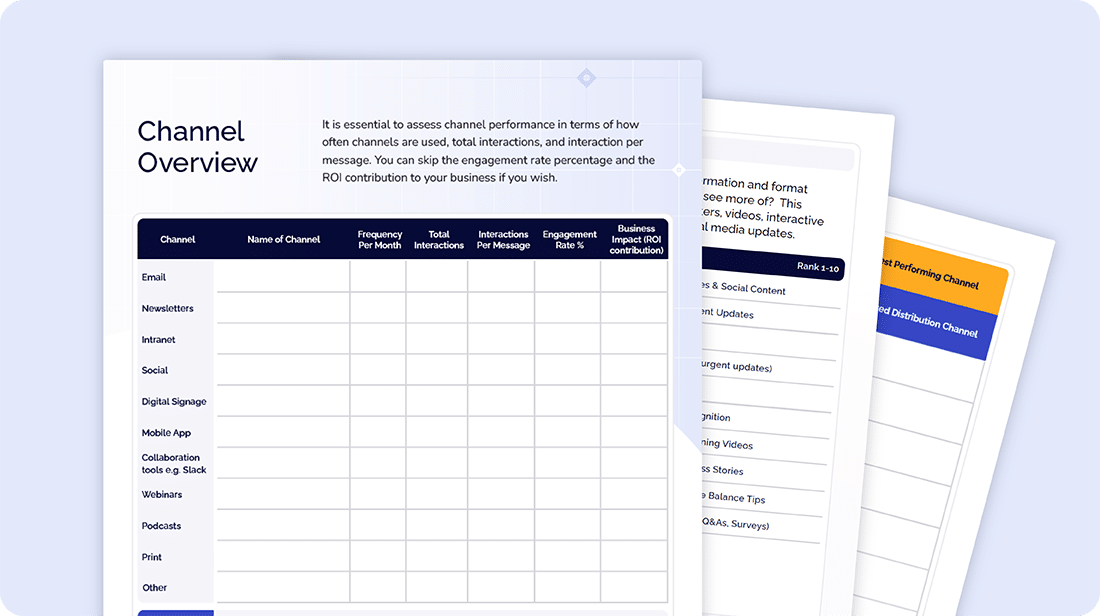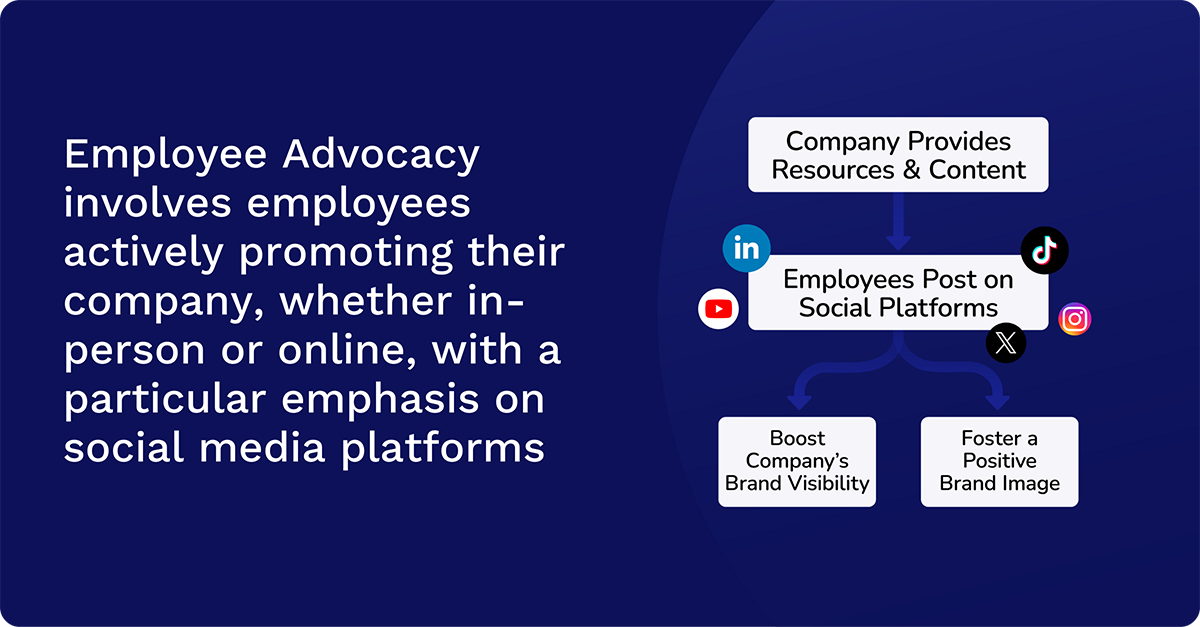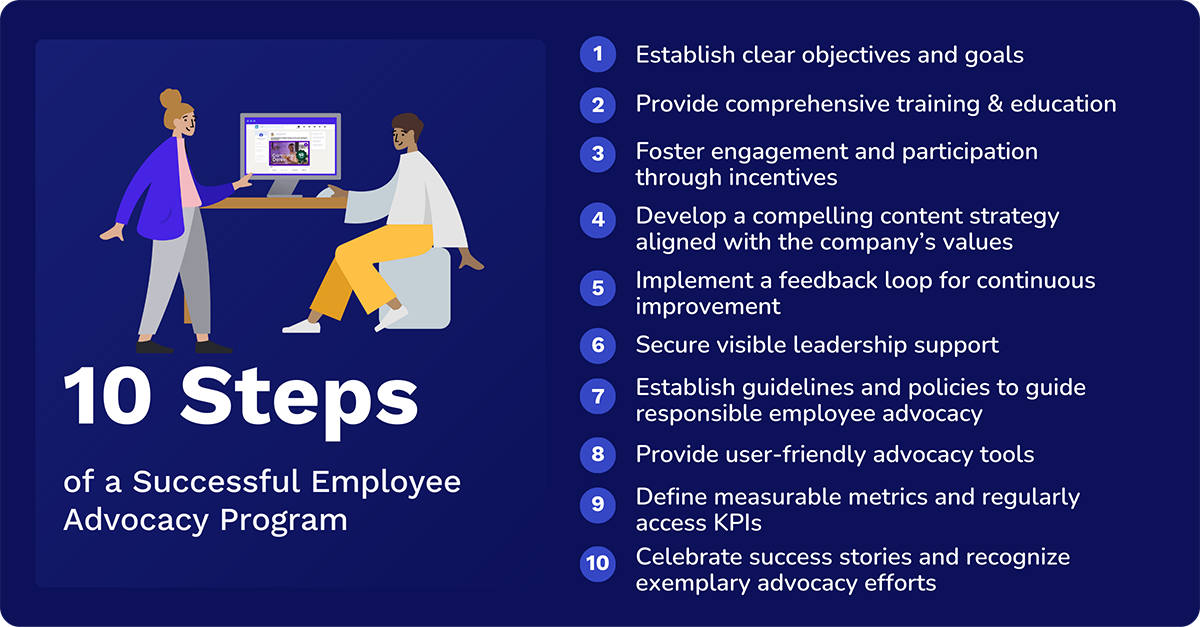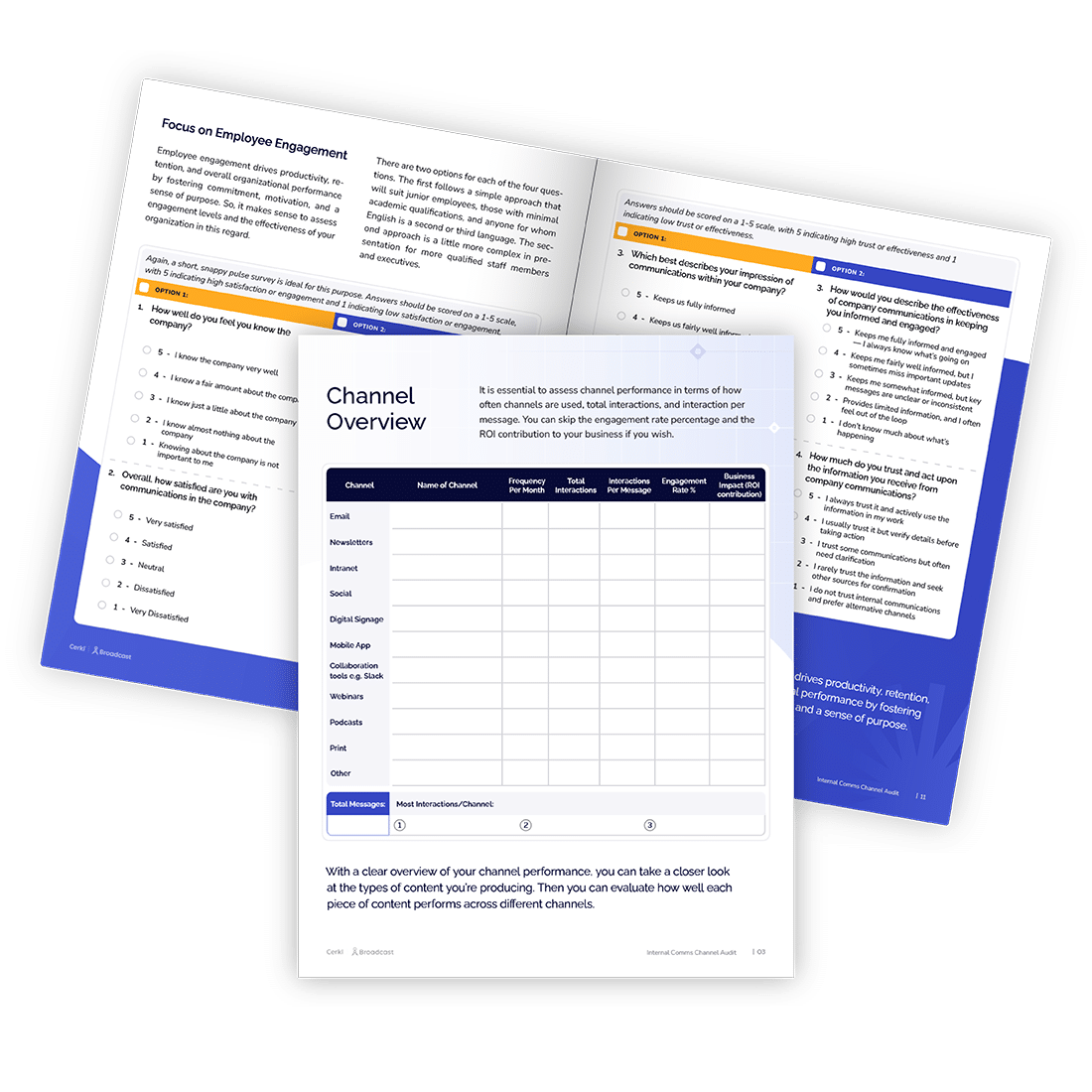Learn how employee advocacy can empower your staff and exemplify your brand. You may be surprised how powerful it can be, and how much it matters.

.png)
Strategy is an important component of internal communications. Ensure you’re communicating through the right channels at the right frequency with our Internal Communications Channel Audit worksheet.
Access NowEmployee advocacy is important because inviting employees to own part of your company’s social dialogue reinforces their value. We often talk about our jobs with our friends and neighbors. How many times have you asked your pals, “How’s the job going?” or perhaps, “What's your company like to work for?”
People trust individuals they know, like, and trust! People also like to connect with other people. So, it stands to reason that employee advocacy has the potential to humanize your company brand and make it personal and trustworthy.
A much-quoted study published by Gartner in 2022 predicts that by 2023 “90% of B2B social media marketing strategies will incorporate scaled employee advocacy programs.” This is because when employees share content, it achieves a hugely increased click-through rate (CTR) than when the organization shares it. It also increases employee engagement and productivity.
“Marketing leaders would do well to scale employee participation with easy-to-use platforms that equip their colleagues with a steady stream of content to share on their personal social accounts.”
Gartner
There is no doubt that employee advocacy is a powerful tool. Gartner hasn’t said whether its 2022 predictions were right, but there is loads of evidence that employee advocacy works. So, we’re going to explore what exactly employee advocacy is, what its benefits are, and how you can establish a successful employee advocacy program. We will also show how you can measure and track the success of your employee advocacy program.
Upgrade your company’s internal comms to enhance employee communication

The roots of employee advocacy go back decades, but its popularity is largely due to the rise of social media in the 2000s. It has continued to gain popularity as employees have gained access to new platforms that enable them to share information and opinions.
A 2020 study defines employee advocacy as “an emerging and cost-effective concept of employee amplification to market products and services by enabling employees to build and share the company's brand contents through social media platforms.” The authors of Employee Advocacy as a Marketing Strategy to Power Brand Promotion: An Employee Perspective urged that employee advocacy shouldn’t “be considered simply an act of sharing photos and videos of company-related matters or encouraging employees to be on social networks during their free time for the employer.” They felt strongly that there should be “explicit rules and guidelines for using social media platforms for amplification activities.”
In a Forbes article that explores how to measure the full impact of employee advocacy, Glenn Gaudet defines employee advocacy as “the marketing initiative by which companies provide employees with the training and tools to engage prospects and customers digitally.” The founder and CEO of GaggleAMP, an employee advocacy and social media management platform, Gaudet states that it drives both tangible and intangible benefits for businesses. But it’s important not to focus on the tangibles too much. Intangible benefits that you can’t measure easily can be incredibly beneficial too.
Simplified, employee advocacy involves employees actively promoting their company, whether in-person or online, with a particular emphasis on social media platforms. An organized employee advocacy program focuses on providing employees with resources and content to leverage their social media presence. Ultimately, the aim is to boost the company's brand visibility and foster a positive brand image.

There is strong evidence that increased employee advocacy and engagement of employees are linked. The Quantum Workplace 2023 Employee Engagement Trends Report, Driving Employee Success, shows that the investment in employee engagement results in increased employee advocacy, as stated by 30.6% of survey respondents. In addition, engaging employees directly impacts employee satisfaction (49.7%) and employee retention (38%).
We know that employee engagement is entrenched, and totally dependent on, internal communications. So it’s a bit of a shock to discover that few organizations believe that internal communications drives employee advocacy.
Only 15% of the respondents in Gallagher’s State of the Sector 2022/23: Internal Communication and Employee Experience survey think that the purpose of internal communications is employee advocacy. According to the report, it’s the least important factor, even for those who are in marketing roles. Culture and belonging (74%), strategic alignment (67%), organizational agility (47%), risks (29%), customer experience (25%), and talent retention (22%) are all considered to be much more important.
When questioned about their environmental, social, and governance (ESG) commitments into the employee experience, employee advocacy ranked a little higher. Most respondents (36%) said they don’t communicate about ESG, while 26% said they do inform employees about their ESG activities and commitments. Overall, 12% agreed that they encourage employees to support their local communities and charities, while 12% drive employee advocacy around their ESG commitments.
Upgrade your company’s internal comms to enhance employee communication

In theory, employees should be any company’s biggest cheerleaders. Over time, more and more, companies are finding creative ways to encourage employee advocacy — a strategic, sustainable, organic program that drives employees to promote the brand that they work for. In turn, employees must feel connected to a supportive environment that allows them to feel valued and contribute to the company’s success.
Many companies, including Cerkl, have masterfully encouraged employee advocacy via social media. A corporate communications team can’t encourage employees to share their perspectives and work experiences to amplify a company’s products or services without the foundational work to create an employee experience. If you’re missing an employee-first work culture along with a proactive communications strategy that is focused on attracting and retaining exceptional talent, you can’t expect your employees to serve as brand advocates.
The fact is that many employees experience a strong sense of belonging. According to the Achievers Workforce Institute 2023 Engagement and Retention Report, The future is flexible, they are 69% more likely to recommend their employer as a great place to work. In addition, employees who have access to connection tools at work report:
Through their social networks and interactions, employees can significantly amplify a company's reach, introducing the brand to a much broader audience. Sharing company updates, achievements, and relevant content on social media platforms increases the likelihood of reaching potential customers who may not have otherwise been exposed to the brand. Furthermore, consistent and positive mentions from employees contribute to a more recognizable and memorable brand, reinforcing its presence in the market.
A LinkedIn Talent Solutions report, Turning Employees into Brand Advocates provides four steps to creating an effective employee engagement program. It states that on average, your employees have a network that is 10 times larger than your company’s follower base. The same report points out that content has twice as much engagement when shared by employees. Also, companies with high numbers of employees sharing quality content are 58% more likely to attract talent.
When employees authentically share their experiences and perspectives, it adds a human touch to the brand, making it more relatable and trustworthy. Personal recommendations from employees are often perceived as more genuine and credible than traditional marketing messages, fostering trust among customers and potential clients.
Employee advocacy serves as a form of social proof, validating the company's claims and values through the real-life experiences and endorsements of its workforce.
Genuinely authentic, trusted communication channels have the potential to attract new customers. Furthermore, a strong employee advocacy program showcases the company's positive culture, values, and work environment, making it more attractive to potential job candidates.
Current employees acting as advocates can play a crucial role in attracting top talent by sharing their own positive experiences working for the company.
Employee advocacy fosters a sense of pride and belonging among the workforce. Furthermore, it contributes to higher job satisfaction and lower turnover rates, as employees become more invested in the success of the organization.

An employee advocacy program is a structured initiative implemented by a company to encourage and empower its employees to actively promote the organization, its products, services, and values. These programs typically provide employees with the necessary tools, resources, and guidelines to share company-related content on their personal social media networks. This amplifies the brand's reach and fosters a positive corporate image.
Employee advocacy programs aim to leverage the authentic voices of employees to enhance marketing efforts, improve brand visibility, and strengthen the company's overall reputation. A good employee advocacy program will provide opportunities that your employees can share.
Every aspect of the company from operations to human resources has cyclical programs that can offer amazing opportunities for your employees to share the company’s culture and strategic business initiatives. Here are some ideas:

A successful employee advocacy program requires a strategic approach. Here are 10 important steps that you can follow:
Let’s focus on some of the most important issues.
Brand advocacy is all about partnering with employees to share important company happenings in their own words, but in order to do so, they need clear guidelines. Well developed, employee advocacy programs are the way to go. But how?
HR and legal leadership need to develop a social media policy if you don’t already have one. And you need this policy in place months before even thinking about ways your employees can be brand advocates. Most companies cover social media etiquette in the employee handbook. However, you need to make sure policy aligns with how you want to structure your employee ambassador initiatives. Employer commentary on personal social media accounts differs from employees’ interactions with special hashtags or corporate social media accounts. For example, employees must not post personal identifiable information (PII) about your customers or colleagues. PII consists of full names, addresses, phone numbers, employee IDs, etc. Moreover, you’ll need to ensure that employees are obtaining approval before naming or posting their team members’ photos.
Implement a blanket photography release form upon onboarding new employees or mandate release forms each time employees are photographed publicly. Either way, you must have a clear process for gaining these approvals when colleagues are posting photos of team members.
Before you encourage employee advocates to promote the company, make sure that your leadership can model how it’s done. For instance, they can guide employee advocates to:
Make sure a member of the communications or marketing team manages and monitors your handles and hashtags across all platforms. It’s effective if you establish a two-way conversation and work with your team to retweet/repost to other company X (formerly Twitter) handles, Facebook or Instagram pages, or LinkedIn groups. With Cerkl Broadcast, you can link your external website feeds to Broadcast’s Content Hub to automate some of your content development.
Companies are often well-intentioned about ways to build employee voices through marketing and other social media channels. But too often communications teams can pigeonhole employee voices when they limit social dialogue to only a few initiatives. For optimal success, brand advocacy must be multi-dimensional and omnipresent. Companies must provide authentic advocacy opportunities to share what it’s like to be part of the company. Think about how employees help to:
Provide comprehensive training on social media best practices, company messaging, and program guidelines. This is the best way to empower employees with the knowledge and skills needed to effectively represent the brand, building confidence and consistency in advocacy efforts.
Be aware that you are likely to lose credibility if you offer incentives for employees to share their positive work experiences on social media. For example, employees who share company-sponsored volunteer opportunities on social media have been seen to be entered into an iPad drawing. It can easily become a contest rather than an omnipresent cultural activity that empowers employees to share why they’re proud to be working for the company. And it happens!
Instead, encourage social media advocacy by looking at easy ways to recognize employees’ brand ambassadorship on your social media platforms. This activity should be part of your ongoing employee communication content plan. Look at interesting corporate storytelling opportunities to recognize employees who share their tweets and posts about ways they are supporting customers or congratulating team members. As you cultivate this content, designate an area of your intranet to showcase your company’s social media activity. Use social posts to encourage short recaps on their contributions to the community, volunteering, or teamwork.
Oftentimes, communicators don’t have time to write up business unit-specific communications. With workflow options within Cerkl Broadcast, you can give key content contributors limited access to create and target content. You can even set up permission levels for contributors to create content while you keep reviews and approvals within the internal communications team.
Provide accessible and user-friendly tools or platforms that simplify the process of sharing content. This will make it convenient for employees to engage in advocacy efforts and seamlessly integrate them into their daily routines.

It is vital to measure employee advocacy success to be able to evaluate and analyze the effectiveness and impact of an employee advocacy program. This involves assessing various key performance indicators (KPIs) and metrics to determine how well the program is achieving its goals and contributing to the overall success of the organization.
Define key performance indicators (KPIs) and regularly assess the impact of the program. This is essential for measuring metrics such as reach, engagement, and sentiment to gauge success and identify areas for improvement. This measurement typically includes evaluating factors such as increased brand awareness, engagement levels, reach on social media, employee participation, and the program's influence on recruitment and retention. By quantifying these aspects, companies can gauge the success of their employee advocacy initiatives and make informed decisions to optimize and enhance the program for continued positive outcomes.
There are many tools that we can use to track and analyze KPIs. These include employee advocacy platforms.
Think about the key pillars of your organization. Could you offer a hashtag for employees who work directly with customers? What about your corporate social responsibility initiatives? Perhaps an environmental sustainability hashtag or handle will inspire employees to share how they value the work of the company.
Think about your company’s long-term initiatives and how you can involve employees. Equip employees with a social dialogue one-pager that connects the initiative’s key messages with your organization’s mission, vision, and values. It’s also important to align your social media presence with employees’ areas of interest. This should be in line with personalized brand advocacy opportunities based on job roles with the company. Think about how to showcase career journeys, professional development opportunities, volunteerism, and employee resource groups.
With Broadcast, we set the foundation by personalizing communications based on employees’ content preferences. There will always be news and announcements that employees must read to stay informed. But you have the opportunity to engage employees by also delivering content that interests them most. Using this personalization communications model, your communications team can share opportunities to connect and represent your brand within a social dialogue.
When executed with care and authenticity, creating opportunities for employees to serve as social brand ambassadors can add another layer of engagement into your company’s work culture. Your team just needs to make sure employee experience is the central focus.
Do you want internal communications that will revolutionize the employee experience and work culture within your organization? Sure you do. Are you aware that Cerkl Broadcast can provide the tools that you need?
But first, we advise that you audit your existing internal comms plan. Our strategic internal communications audit will help you do this quickly, easily, and without a fee. You can access our free audit template here.

Upgrade your company’s internal comms to enhance employee communication
What is employee advocacy? Employee advocacy is when employees promote their company by its employees. They do this by actively sharing positive information about their workplace on social media or other platforms.
Which is an example of employee advocacy? An example of employee advocacy is when an employee shares a company blog post on their personal social media account, expressing support for their employer and its values.
What is an employee advocacy program? An employee advocacy program is a structured initiative where a company encourages and supports its employees to actively participate in promoting the organization, often providing resources, training, and incentives.
What is an example of employee advocacy? An example of employee advocacy could be a company launching a program that encourages employees to share job openings on their social networks to attract potential candidates as part of the company's recruitment efforts.

Upgrade your company’s internal comms to enhance employee communication